Hello! It’s Chou-Tac,
If you want to discover the fascinating world of Interior Architecture Designer,
I’m thrilled to welcome Pradnyaa Desai on the blog! She is an Interior Designer from Malaysia, Kuala Lumpur. I discovered her amazing sketches ful of Emotion by browsing randomly on LinkedIn – and her style attracted my eyes!
And Tadaa!!
I wanted to share her amazing creation with you guys,
and best of it, Pradnyaa accepted to teach us her creative workflow!
Instagram: @the_sketchy.pen
YouTube: The Sketchy Pen
More: linkbio.co/thesketchypen
TRY THIS:
Imagine yourself as one of those human silhouettes —walking toward the sofa and settling in comfortably.
As you sit, you look around you. How does it feel to be part of this space? Maybe you can almost sense the texture or even smell the perfume of the chair’s leather.
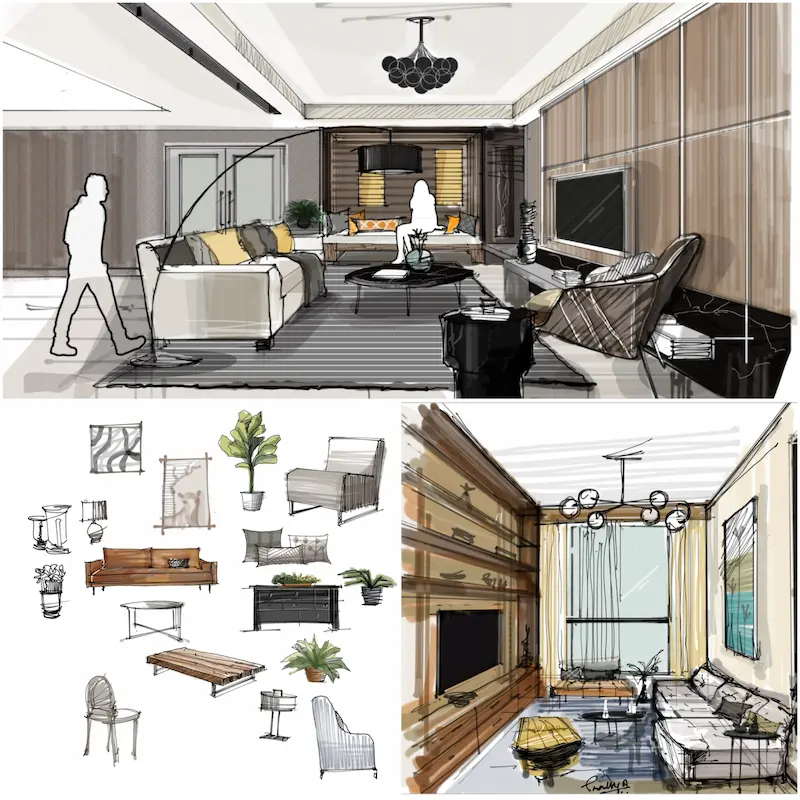
Let’s discover the behind-the-scenes of Interior Architecture together from her unique point of view!
Thank you so much Pradnyaa. 🙂
Now let’s start!
- Personal Life & Background
- Is Drawing a Learnable Skill or a Natural Gift?
- Inspiration & Resources
- The Role of Emotion & Sketching in Interior Design
- Balancing Artistry and Functionality in Home Interior Design
- Learning & Growth as an Interior Designer
- Philosophy & Advice for Aspiring Interior Designers
- Final Word: If someone wants to get into interior architecture, what practical steps can they take right now to get started?
Personal Life & Background
I’d love to get to know you a bit better.
I lived in Singapore, so Malaysia always felt like a close neighbor to me.
Could you share your story and where you’re from?
Hello Chou-Tac!
Firstly, thank you for this opportunity. I’ve been following your work for a while now and really admire what you do—so it’s a pleasure to finally connect and be a part of this!
I was born and raised in Mumbai, India.
With my dad as a technical architect—our home was always filled with floor plans, construction drawings and architecture books. That probably became the subtle backdrop to my world.
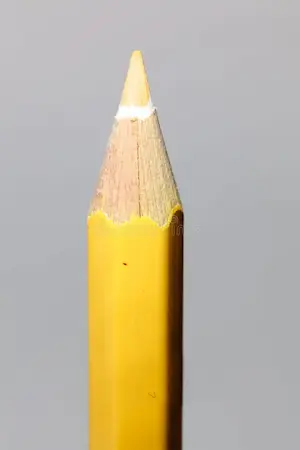
As a quiet, observant child,
I was more captivated by crayons than toys, likely owning more coloring books and pencils than anything else. That creative spark showed up early, and thankfully, my parents encouraged it.
Over time, my passion for art developed into a broader perspective on design—not merely as aesthetics or objects, but as something deeply connected to people, their emotions, and the way a space can quietly shape how they feel.
How would your friends and family describe you in 5 words?
Probably:
- creative,
- observant,
- composed
- and someone who takes things in stride
- patient and practical mostly.
Do you have a favorite cuisine or dish?

I enjoy a mix of cuisines—Chinese (especially Hunan recently acquired actually with my trips to HongKong) , Thai and Arabic, with a special love for Lebanese food. Still, Indian food, like mutton dum biryani and Goan seafood, holds a special place in my heart.
Living in Malaysia, I’ve also grown fond of Nasi Lemak and spicy seafood Laksa.

Do you find inspiration from Malay or Malaysian culture in your designs?
Yes, definitely.
My journey into hand-sketching interiors began here, deeply influenced by the vibrant artistic vibe around me. Traditional Malay architecture, with its timber, plants and natural materials, along with vibrant textiles, profoundly influences my designs, adding depth, warmth and cultural richness to the spaces I create.
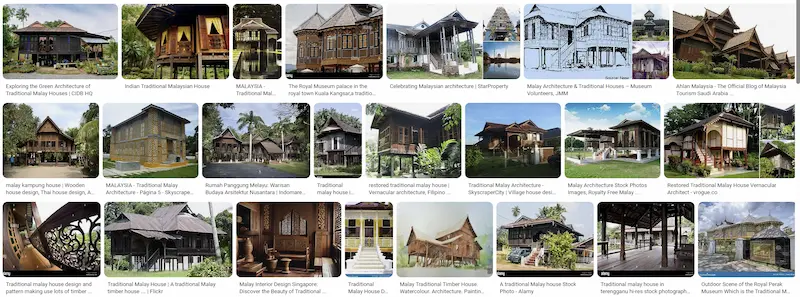
It’s not just tradition that inspires me—I’m equally drawn to the sleek modernity of Malaysia’s urban vibe and the vibrant street art in Kuala Lumpur, where the old and new blend effortlessly.
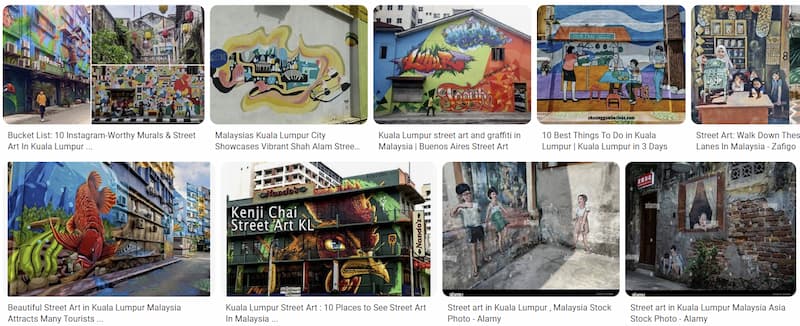
The country’s diverse cultural mix encourages me to weave these influences together, giving each space its own unique story.
My design process, which blends traditional sketching with modern digital tools, reflects this fusion symbolically, merging craftsmanship with innovation.
How did you acquire your interior design and sketching skills? Did you study interior architecture formally, or are you self-taught?
I studied Interior Design at Rachana Sansad School of Architecture in Mumbai, where I developed a strong foundation in:
- spatial thinking,
- technical drawing,
- and design principles.
The rigorous curriculum, guided by inspiring professors, played a pivotal role in shaping my career.
Sketching was central to my education, but as I started working, I became more immersed in AutoCAD and 3D modeling, and hand sketching took a backseat.

My growth truly accelerated through hands-on experience—first running my own interior design business in Mumbai and later working at a boutique design firm in the UK, designing spaces across various styles.
It was during the pandemic that sketching made its way back into my life, allowing me to reconnect with it as a core part of my design process.
I connected with a community of designers and gradually transitioned from analog to digital sketches, refining my sketching skills into what they are today.
How has your personal story influenced your approach as an interior designer?
I began taking on small projects while still in design school, alongside studies.
I also worked with a design firm, building expertise in kitchen design and residential interiors. I went on to establish my own interior design practice in Mumbai and ran it successfully for five years.
Over time, my roles shifted as a designer working across different cities and countries, namely UK & Malaysia. Each of these chapters has added a new layer to how I see and approach design.

Living in different cultures taught me how everyday habits and ways of living shape design choices in real, practical ways. One experience that really stands out is my time working as a kitchen design specialist across countries, where I saw how local cooking practices, climate, and cultural preferences directly influenced layout, materials and work flow.
This experience shifted my focus toward designing for livability and functionality rather than aesthetics alone.
Today, I see homes as living, breathing ecosystems—constantly considering how families interact with space, where memories are created, and how thoughtful details can bring joy to everyday life.
Is Drawing a Learnable Skill or a Natural Gift?
Do you believe anyone can learn to draw well enough to communicate interior design ideas?
Absolutely, I believe anyone can learn to draw.
I say this as someone who always loved drawing, but truly invested in honing my professional sketching skills much later in life—especially during the pandemic when I committed to it more as a daily practice.
I see drawing as a language—you don’t have to be born with the ability to speak it fluently.
With focus, observation, and consistent practice, anyone can learn to sketch well enough to confidently communicate their design ideas.
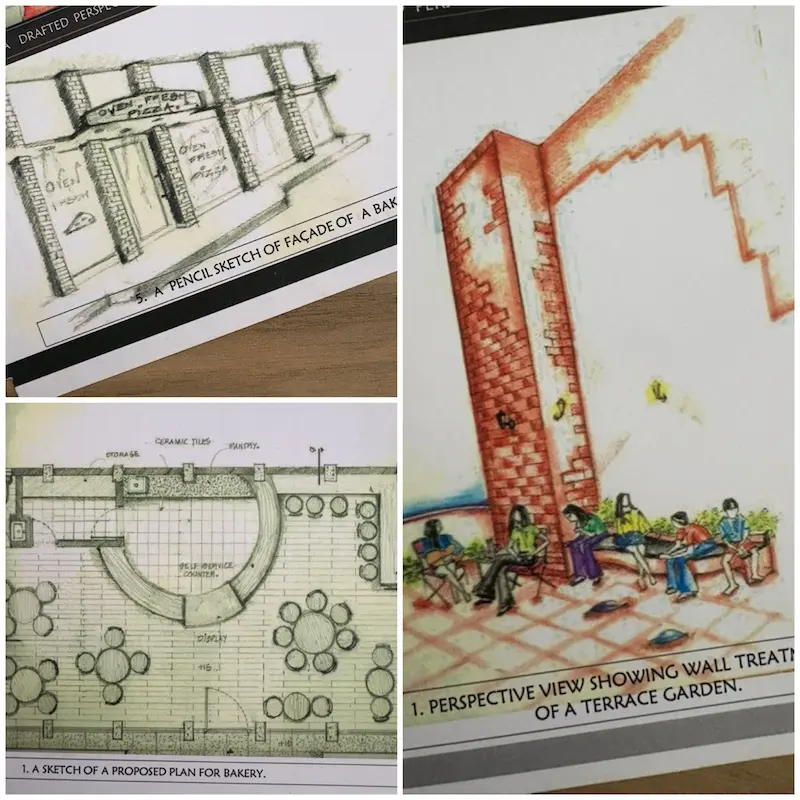
What advice would you give to someone who feels insecure about their drawing abilities but dreams of becoming an interior designer or home decorator?
Don’t let drawing hold you back.
You don’t need to be amazing at sketching to become an interior designer. Drawing is just a tool to communicate your ideas, and as long as it it does that, it’s doing its job. Still, sketching can be a powerful asset.
Start small, be patient, and sketch like no one’s watching.
Tools like tracing paper help build muscle memory, and combining traditional sketching with digital tools like an iPad can make the process feel less intimidating.
Digital drawing platforms play a big part in my workflow—they allow freedom to explore, fix mistakes easily and keep the feel of a hand-drawn sketch. It’s a great way to build confidence,especially if you’re unsure about your drawing skills, because it gives you the freedom to experiment without starting over each time.
At the end of the day, the tool is just a medium.
What matters is the idea behind the line. Your lines don’t need to be perfect—they just need to tell a story.
Every designer starts with crooked lines.
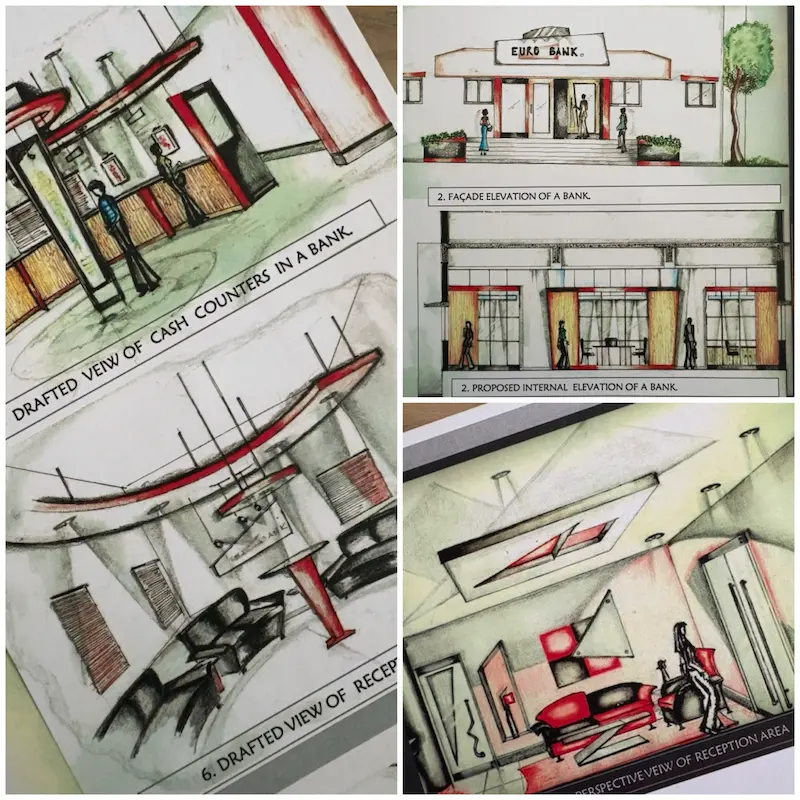
Is it important for an interior architect to find his own drawing style?
Yes, but it happens naturally over time—you can’t force it.
A helpful tip is to follow and study the work of your favorite designers. Imitating and experimenting with their styles and techniques can be a great way to learn, and through that exploration, your own unique style will gradually emerge.
The key is to stay curious, keep experimenting and practising regularly, and let it evolve organically.
Inspiration & Resources
I’m reminded of Salvador Dalí’s quote: “Those who do not want to imitate anything, produce nothing.” It’s a great reminder that drawing inspiration from others is a natural and essential part of creativity.
With that in mind, let’s explore the influences and resources that have shaped your journey in interior architecture!
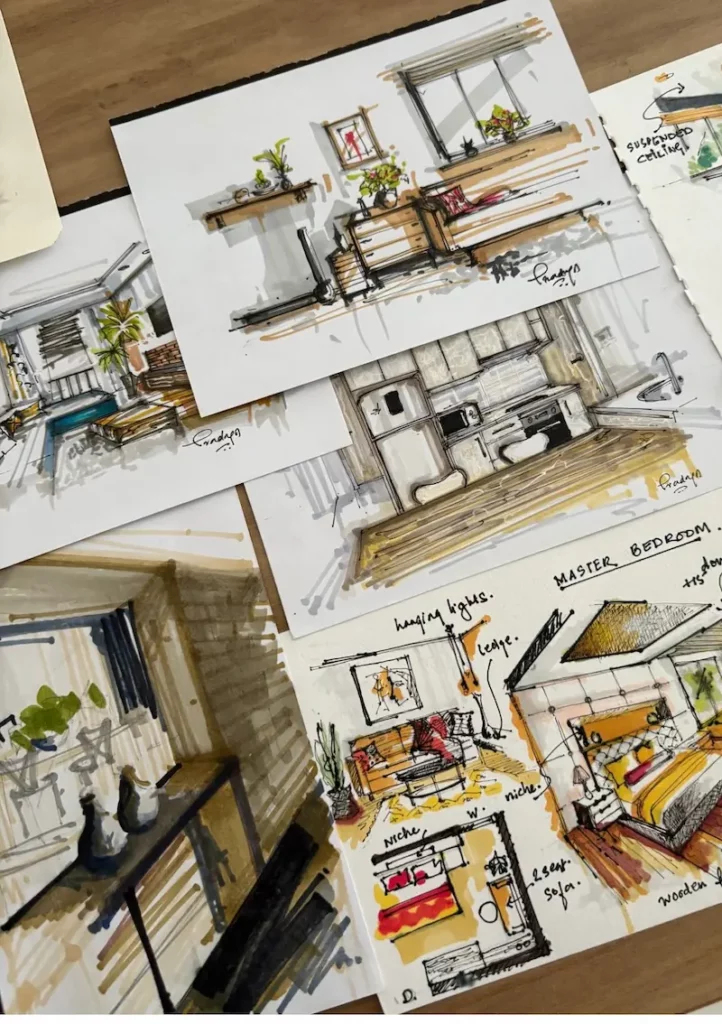
HOBBIES: What hobbies or activities inspire your creativity for residential interior design projects?
Outside of interior design, I enjoy cooking, writing, spending time with friends.
- Cooking teaches me balance and flow, while writing is a quiet companion that helps me slow down and process my thoughts and emotions.
- Sketching outside of work is therapeutic—whether it’s a street, a cozy café, or nature—it keeps me observant and inspired.
- Even simple moments with family, spending time with my kid or a sharing a cup of tea with a friend often spark ideas about how people connect with space, subtly shaping my approach to residential design.
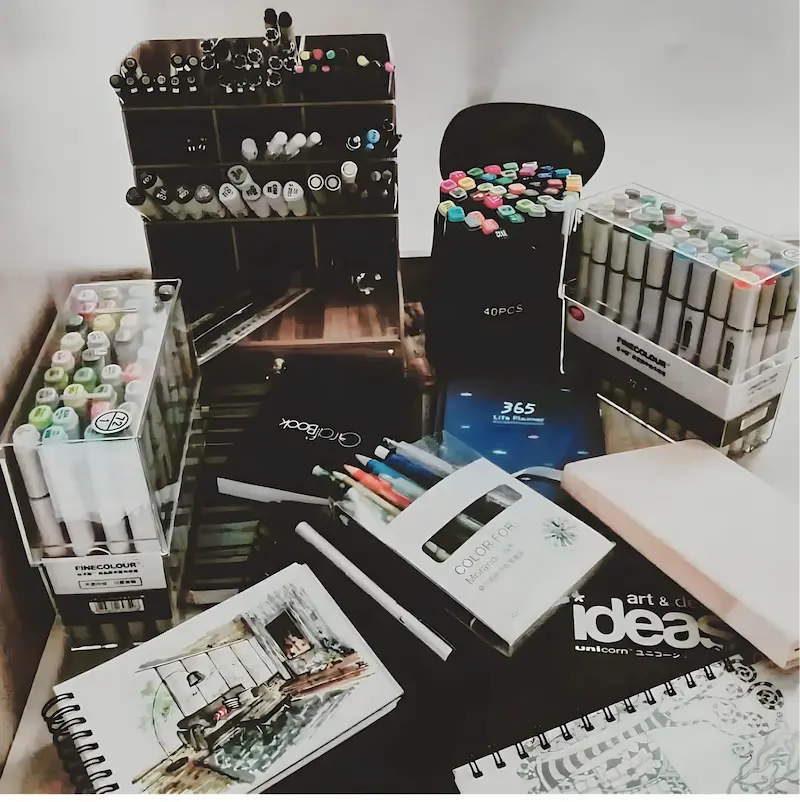
MOVIES: Are there any movies, documentaries, or TV series related to architecture or interior design that you would recommend?

I’ve always enjoyed shows like Extreme Makeover- Home Edition , 60 Minute Makeover and Dream Home makeover all of which were entertaining and powerful in showcasing dramatic transformations and the emotional impact design can have on people’s lives.
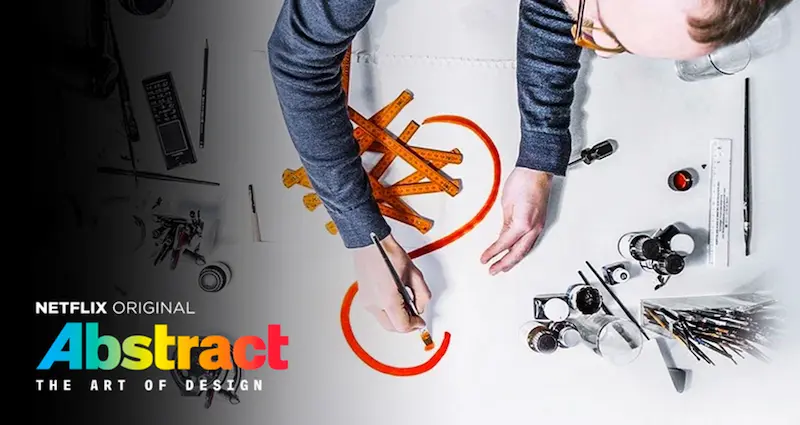
I’m also a fan of Abstract: The Art of Design on Netflix, especially the episodes centered on interior design and architecture. It provides an insightful and personal look into the creative processes of professionals.
I also enjoy estate shows, particularly those where they explore perplexing, unique properties and the process of finding the perfect place to buy.
These kinds of shows, while focused on real estate, still offer interesting design elements, especially when it comes to how different properties are transformed or renovated.
BOOKS: What are your go-to books or publications for inspiration or professional development?
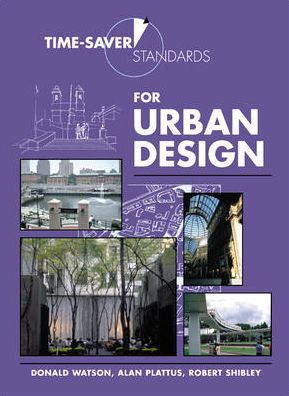
One book I highly recommend, especially for students, is Time-Saver Standards for Interior Design and Space Planning.
It’s a design bible, covering the technical fundamentals of interior design, from ergonomics and anthropometry to layout planning and spatial relationships.
I relied on it heavily during college and early in my career. Though it’s more technical than inspirational, it provides an essential foundation for creating functional and well-planned spaces—knowledge that’s key for any designer.
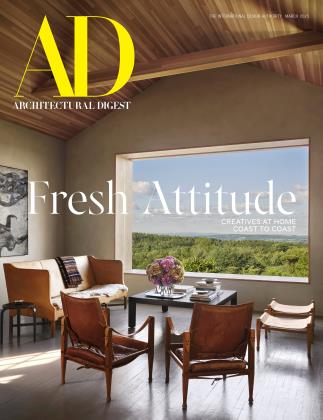
I also regularly browse architecture magazines and design annuals for inspiration on color palettes, trends, and space planning.
Publications like Architectural Digest and Elle Decor that offer timeless, luxurious styles, while digital platforms such as Design Milk and Apartment Therapy keep me updated with fresh, modern ideas and the latest design trends.
MUSIC: Do you listen to music when you draw?
Always!
I usually listen to instrumental soundtracks without lyrics—techno instrumental, sometimes calming music, and even film scores. It helps me focus and gets me into a flow state while sketching. The rhythm and mood of the music really get me into the creative zone, especially when I need a boost.
DESIGNERS: Are there any interior designers or artists who have had a significant impact on your work?
Frank Lloyd Wright’s philosophy has deeply influenced me since my early design days. His ability to connect architecture with nature—creating spaces that feel organic, open, and timeless—continues to inspire how I think about design and how I view spaces as cohesive, interconnected environments.

When it comes to sketching, I draw a lot of inspiration from David Drazil and Olga Sorokina.
I really admire David’s clean, minimal style that holds strong architectural clarity and Olga’s way of blending technical precision with emotional expression—her interior sketches feel like art.

Their distinct approaches reminded me of the power of hand-drawing in design, and played a big role in me deciding to take sketching more seriously, and eventually pursue it full-time.

DESIGNER TIPS: Can you share with us some tips to overcome the blank page?
Yes—just start, even if it’s messy.
Don’t wait for the perfect line or layout.
- I usually begin with loose lines, bubbles, scribbles, or a simple rough shape—anything to break the blank page.
- Let the sketch evolve as you go, and don’t hesitate to annotate along the way.
- Add notes as ideas come.
- Sketch what you feel before trying to get it “right.”
- And always keep a sketchbook nearby—it’s your creative playground, a space to explore where ideas can flow freely without pressure.
The Role of Emotion & Sketching in Interior Design
Pradnyaa, I came across your Morpholio interior design sketches on LinkedIn and was really drawn to your style. Your sketches do a wonderful job of capturing the atmosphere of a space and showing how design and emotion go hand in hand.
The drawing board where you draw each furniture of your set up, side-by-side is just so cool! I felt I could miniaturize myself, jump into your drawing and go sit on the colorful and comfy sofa you made!
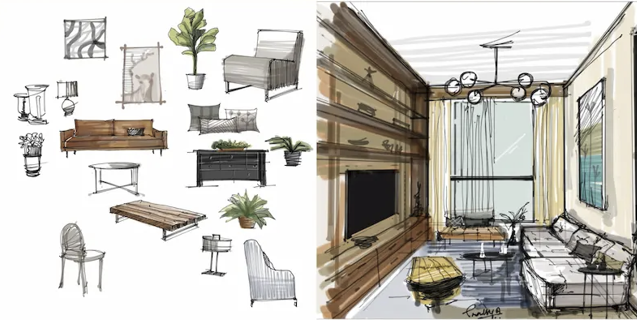
Your interior design sketches are so full of life and emotion!
How do you approach conveying emotion through your drawings and initial interior design concepts?
Thank you so much—that truly means a lot.
For me, every sketch is a story in motion. I’m not just drawing walls or furniture; I’m sketching how a space feels.
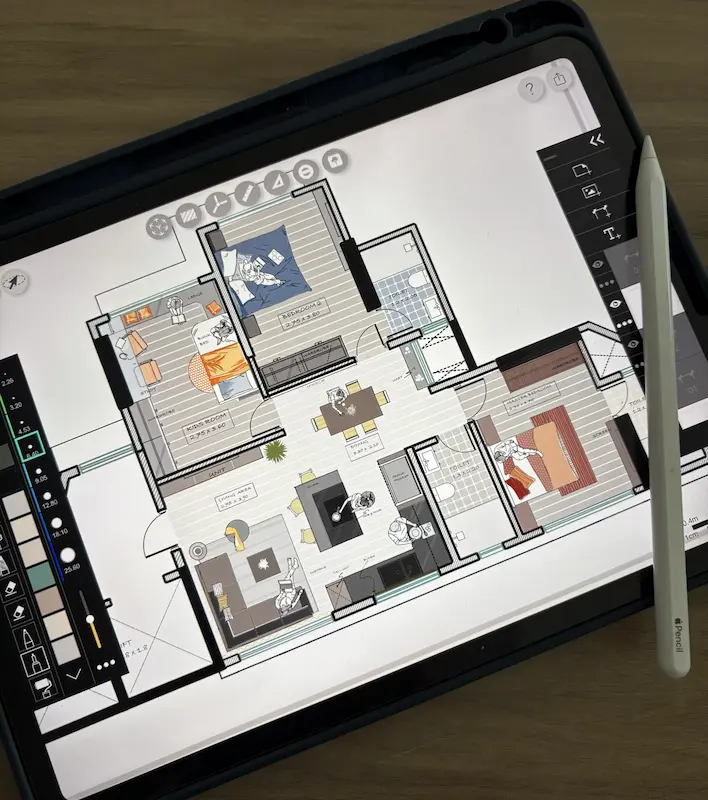
I think about how someone would move through it, where morning light might fall, or where a child might curl up with a book.
I try to bring that emotion into my layouts and perspectives by adding human figures, warm tones, and handwritten notes.
I pay close attention to adding in the little details to the drawing—like accessories, textures, and the natural flow within the space—so the sketch doesn’t just show a design, but captures a lived-in moment.
The goal is always to help someone feel the space before it’s even built.
How does knowledge of color theory impact your design decisions?

Colour theory plays a vital role in every design decision I make.
In interior design, colour sets the tone, defines function, and creates emotional impact. Understanding how tones and contrasts interact helps me craft palettes that reflect the mood and purpose of each space.
This also shapes how I sketch—using colour to add life, warmth, and emotion to concepts before they’re built. While monochrome has its place, colour better conveys atmosphere and intent. For me, colour theory is more than a tool—it’s a key part of storytelling, guiding how a space feels and connects with people.
Why have you chosen hand sketch over 3d software or AI Artificial Intelligence?

For me, Hand sketching remains at the heart of the design process.
There’s something about that direct connection between your brain and the hand-drawn line—it’s immediate, intuitive, and deeply personal. When I sketch, I’m not just visualising a space—I’m problem-solving and imagining how people will live, move, and feel within it.
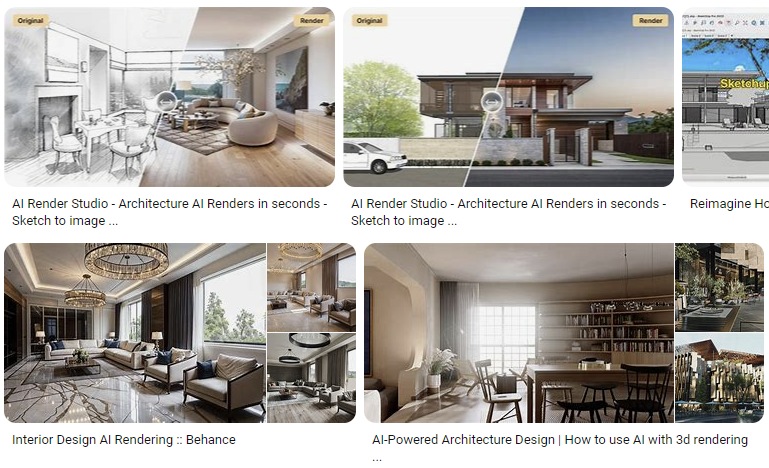
AI is powerful can create photo realistic renders of your design in minutes, but they can’t replicate the warmth and spontaneity of a hand sketched line.
Many designers reach out to me specifically to translate their AutoCAD plans into hand-rendered sketches for client presentations—because that’s what truly resonates with people. And that says a lot.
There’s something inherently human about a hand-drawn sketch. It tells a story, stirs the imagination, and connects emotionally in a way digital images often can’t.
What role does sketching play in your creative process, from initial ideation to final interior design presentation?
From the very first spark of an idea, I turn to my sketchbook (or iPad!) to explore layouts, proportions, and flow through loose bubble diagrams and conceptual vignettes. These quick, hand-drawn thoughts help me get a feel for the space.
As the concept develops, the sketches become:
- richer—layering in materials, textures, furniture, lighting, and mood,
- often with handwritten notes
- and little details that make them feel personal and alive.
Even in the final design stage, I prefer hand-sketched layouts and perspectives.
The fluidity of sketchy lines keeps the design approachable and open. Clients feel comfortable collaborating because nothing feels too fixed, which invites honest feedback and emotional connection. If clients want a hyper-realistic view, I bring in AI tools and 3D softwares—but only at the end. Hand Sketching still leads the way. AI simply supports the journey if needed; it doesn’t direct it.
Can you show us in pictures, different phases of your creative process?
Here’s a look at a creative process for a kitchen design—beginning with hand-drawn plans, elevations, sketched views and ending with a quick render.
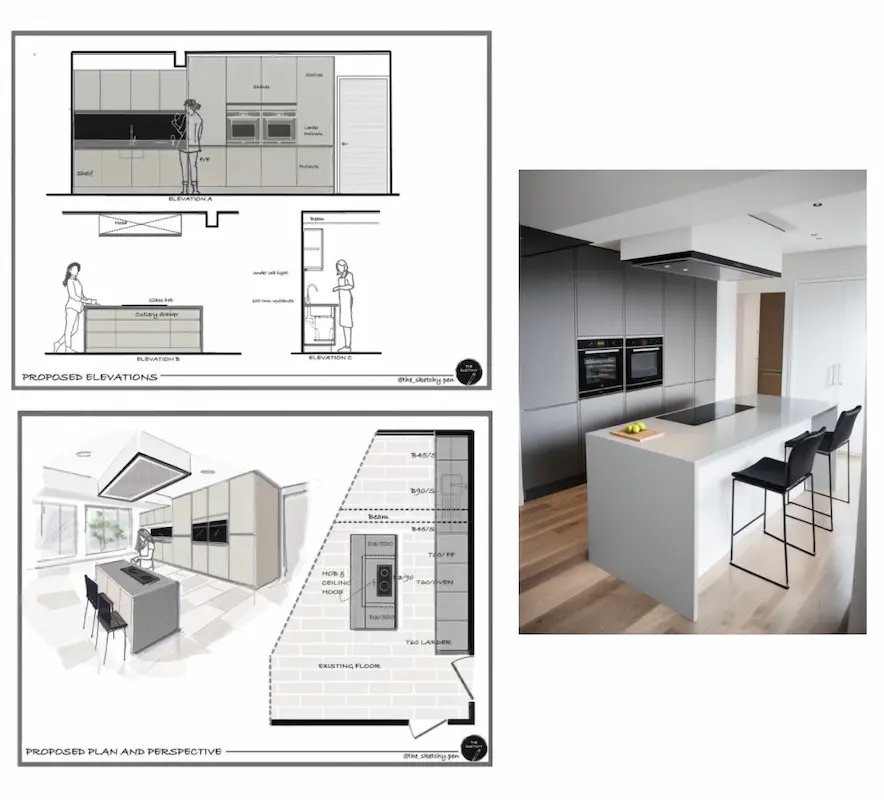
Could you share a story about a residential interior design project where you aimed to evoke a specific feeling or atmosphere for the client?
One standout residential project I worked on was a duplex in Siliguri, West Bengal, created by merging two 4-bedroom apartments. Brought on for conceptual design and space planning, my role was to craft a home that felt both functional and emotionally resonant.
The client’s detailed brief guided every decision—from a warm, welcoming entry to a kitchen designed as the heart of the home. A key challenge was introducing a new staircase to connect the two floors in a way that felt natural and seamless, enhancing flow without disrupting the overall layout.
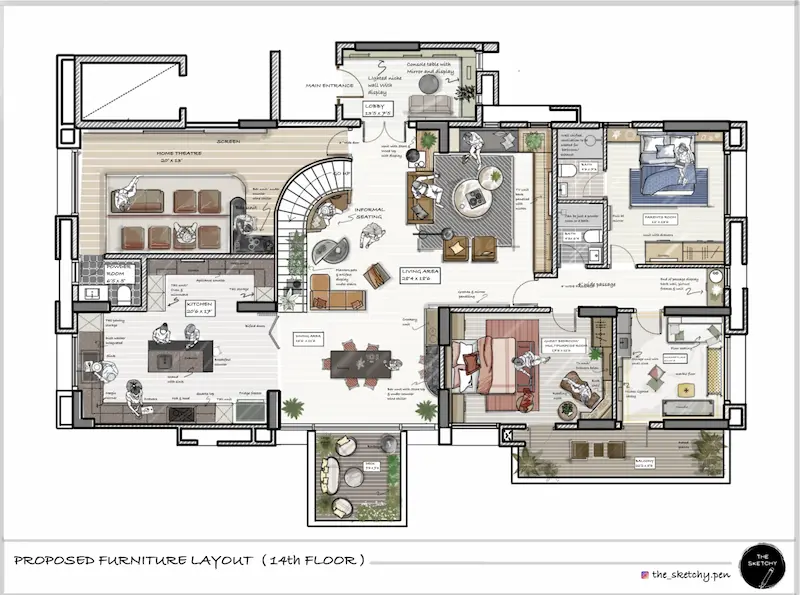
- I redesigned the layout from scratch, opening up the lower level with layered seating, a home theatre, and a large island kitchen for connection and comfort.
- Upstairs became more private—with a serene master suite, playful kids’ room, cozy study, and relaxed family lounge.
What made this project especially meaningful was that I hand-sketched every element—not just floor plans, but lived-in experiences. Using color, texture, and personal touches like books by a window or toys in the kids’ room, I helped the clients envision their their life in the space.
Their emotional connection to the design, even before construction began, was deeply rewarding. Though it’s now in the civil construction phase, the true foundation was laid on paper—through thoughtful details and storytelling.
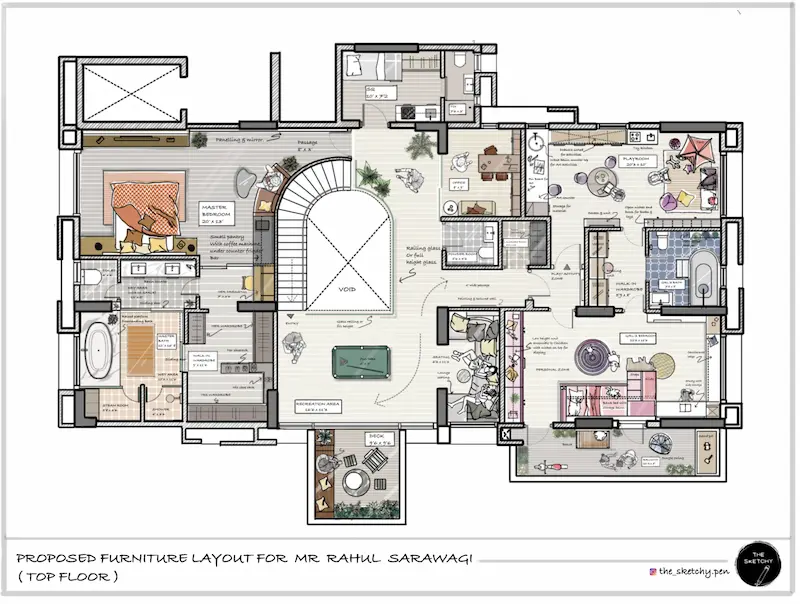
Balancing Artistry and Functionality in Home Interior Design
Let’s talk about how you find the sweet spot between creative expression and practical needs in home interior design.
What does a typical day look like for you as an interior designer?
As a mom and freelancer, no two days are exactly the same—but I do have a rhythm that keeps me grounded.I usually start my mornings early by planning the day ahead, which helps me focus and stay organized.

I work in focused bursts, balancing client projects with home responsibilities and caring for my child. Some days involve creating sketch tutorials or exploring new design tools; other times, I’m developing concepts, sketching designs or reviewing design work.
The flexibility of working on an iPad means I can even take my work to the park while my son plays—creativity fits in wherever it can. It’s a constant juggle, but I enjoy the blend of structure, creativity, and motherhood that shapes my day. No two days are the same, but that’s part of what keeps it all exciting and fulfilling.
Could you also explain how a new interior design project usually begins?
- A project typically begins with a consultation to gather comprehensive information about the client’s needs, style preferences, and budget.
- The space is then assessed through measurements, photos, or an on-site visit.
- Based on this, a design concept is developed and presented.
- After receiving client feedback and making necessary adjustments, the final design—complete with detailed plans, elevations, perspectives, and product recommendations—is delivered.
- Technical drawings, such as electrical layouts, furniture details, and construction documents, are issued at each stage of execution to ensure accurate implementation, whether managed by the designer, contractors or the client.
How do you balance the artistic side of interior architecture with practical considerations like budget, client needs, and technical constraints in residential interior design?
As both an interior designer and sketch artist, I view creativity and constraints as complementary rather than conflicting.
The artistic side fuels the vision—shaping mood, flow, and atmosphere—often beginning with hand-drawn sketches that capture the soul of a space. But from the outset, I’m equally focused on practicality: Will this work? Is it within budget?
- My sketches bridge imagination and execution, helping communicate ideas clearly to clients and contractors while opening up conversations about materials, costs, and feasibility.
- I strive to design spaces that are not only visually striking but also functional and grounded in reality.
- Balancing vision with constraints comes down to smart planning, material insight, and open dialogue.
- True creativity lies in solving problems beautifully within real-world limits—that’s where design becomes meaningful.
Can you share an example of a home interior design project where you had to adapt your creative vision to meet functional requirements or limitations?
I’ve worked on a variety of residential projects, especially during my time in Mumbai and the UK, where I handled several turnkey designs. balancing function and style while tailoring the space to fit each client’s workflow. It’s about making a kitchen that’s efficient, flexible, and visually seamless.

One memorable project was a kitchen I designed in Northampton, UK, where I had to adapt my creative vision to a narrow, unconventional layout.
The client didn’t want it to feel like a corridor of cabinets, and with the cooking range fixed at one end, a traditional layout wouldn’t work.
To solve this, we created distinct zones—including high and low seating—and centered the main working area around the range.
We skipped wall units to keep the space open, adding focal points like full stone risers, a built-in wine chiller, and a sleek wall extractor.
Materials like matte Kashmir-colored doors, Silestone worktops, natural stone flooring, and oak accents were chosen to match the home’s character.
Thoughtful lighting and a custom oak table tied it all together, resulting in a space that was functional, warm, and tailored to the family’s lifestyle.
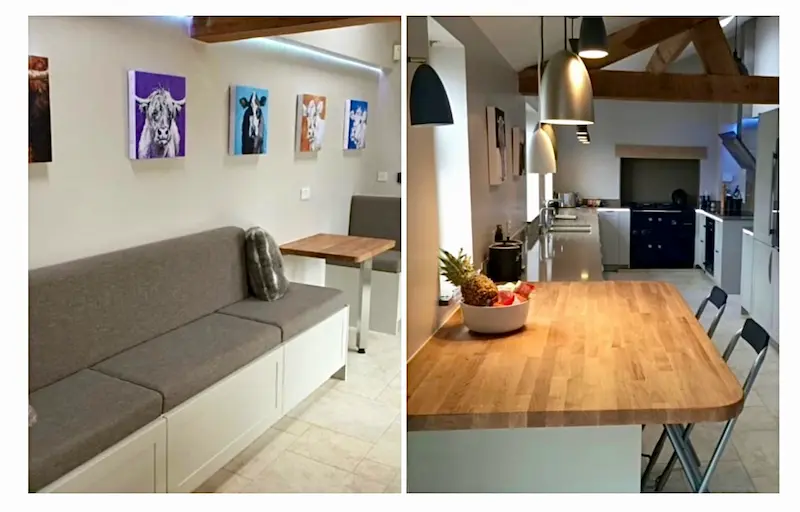
What was the biggest challenge you faced to becoming a professional interior designer?
Relocating across cities and countries has been the most significant challenge in my journey.
Starting fresh in new design markets—from India to the UK to Malaysia—meant adapting to different workflows, tools, and cultural expectations.

It demanded humility, flexibility, and a willingness to listen and learn. Each move came with its own hurdles, but also strengthened my resilience. These experiences deepened my appreciation for diverse cultures and design approaches and the importance of blending global perspectives into my work.
Adapting to new environments has become a key part of my growth, shaping me into a more versatile and open-minded designer.
Learning & Growth as an Interior Designer
Can you show us a picture of your desk / working environment and tools you use?
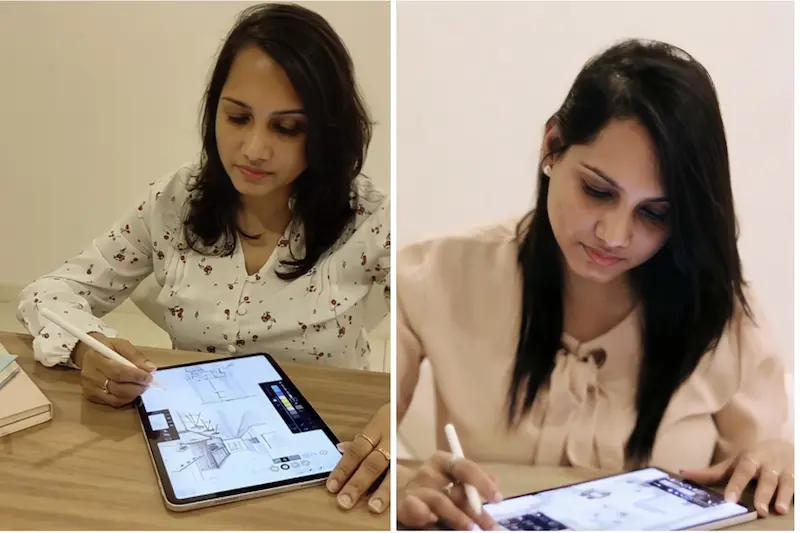
My design process is never linear, so I’m rarely in one fixed place.
Some days I’m at my desk, surrounded by paper sketches, notes, markers, and layout drafts. Other times, it’s just me, my iPad, and Apple Pencil—working from my bed, while traveling, or sketching at the park while my son plays.
I use a mix of tools:
- traditional supplies like paper,
- Micron pens and alcohol markers for hand sketching,
- and digital tools like the iPad and Apple Pencil.
- For architectural and technical work, Morpholio Trace is definitely my go-to—it’s intuitive and designed specifically for architects and designers.
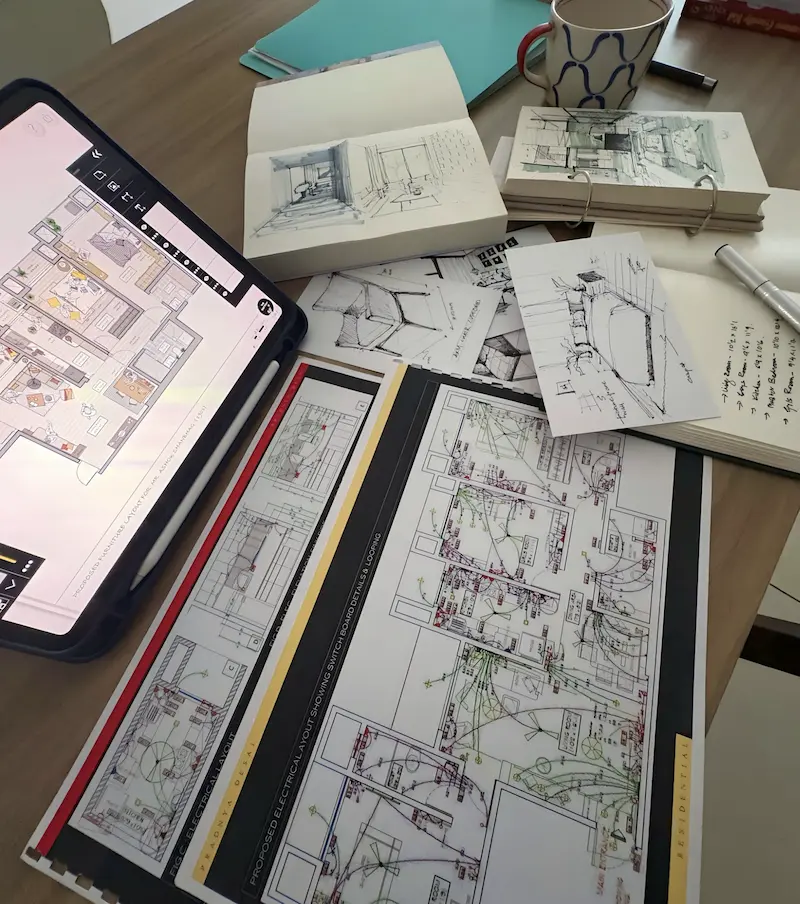
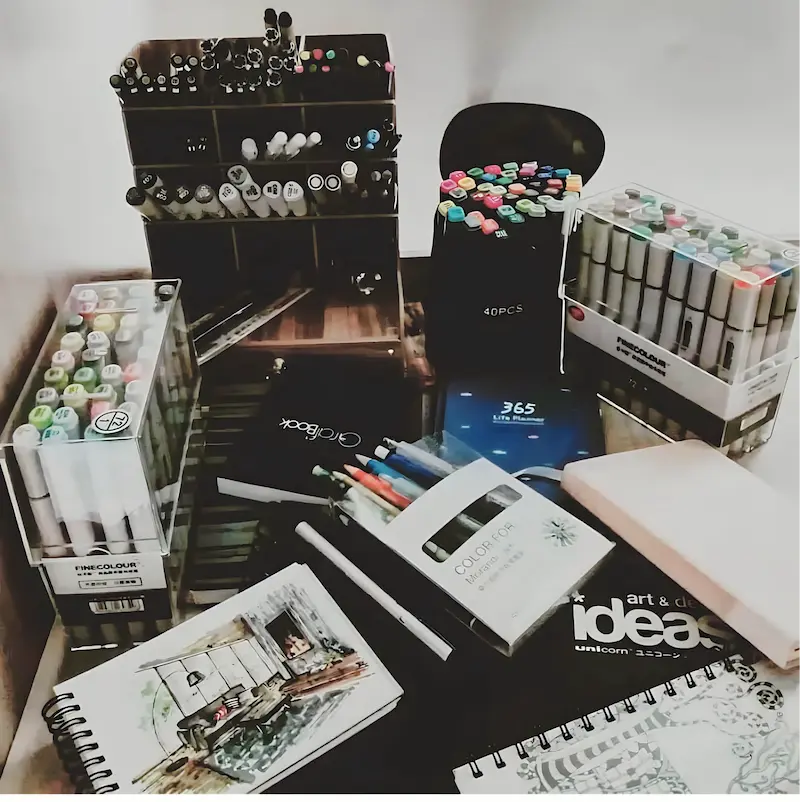
In addition, I also turn to apps like Concepts and Procreate for conceptual exploration and detailing. I also use SketchUp, and AI if the project calls for it, but sketching always remains at the heart of how I design.
It’s a flexible, evolving workflow—shaped by the needs of each project, but always grounded in creativity.
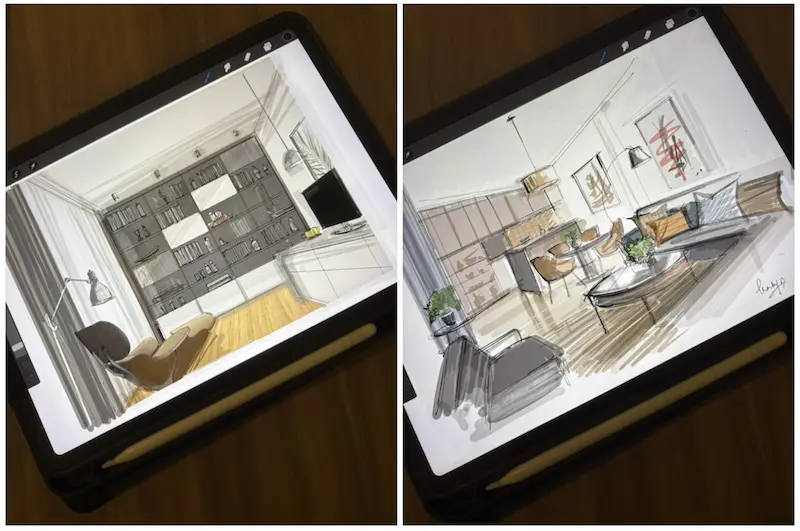
Do you like to draw outdoors, or museum, cafe for example? (a foto would be great)
Absolutely. There’s something special about capturing moments in real time—whether it’s a scene, an object, or simply how we observe light and shadows.

I’ve sketched in cafes, on beaches and in towns—each place offering its own unique inspiration. It’s both grounding and creatively freeing.
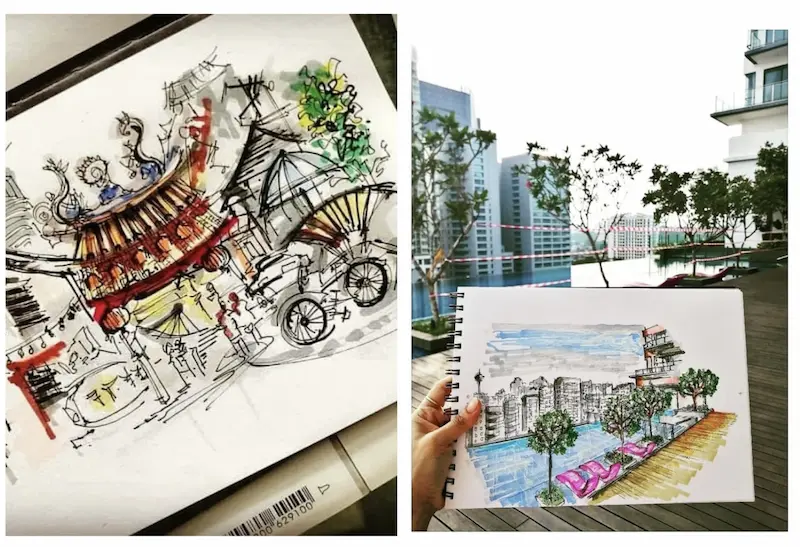
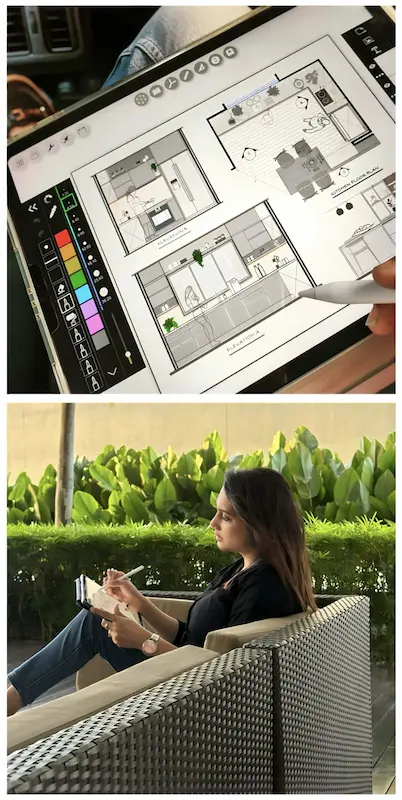
To become an Interior designer, do you need to study about industrial design?
Not necessarily.
While studying industrial design isn’t a requirement to become an interior designer, having a basic understanding of product and furniture design can be incredibly helpful, especially when custom solutions are part of your interiors. In Mumbai, most of my designs were constructed on-site, with carpenters crafting custom pieces tailored to each project. I’ve also collaborated with furniture makers often, so knowing proportions, joinery, and materials does add depth to your design language.
In your opinion, what are the qualities an aspiring designer should have or need to cultivate?
Empathy. Curiosity. Patience.
A good designer doesn’t just make things look good—they listen, observe, and problem-solve.
Also, never stop learning. Design evolves constantly, and so should you.
What is the most common mistake a beginner in interior architecture does? And how can he solve it?
Trying to do too much in one space.
I often see beginners over-layering colors, textures, or design ideas.
My advice: Edit. Ask why before what.
Every element should have a purpose, whether functional or emotional.
What tools or techniques have you found most helpful in developing your interior design sketching and rendering skills over the years?
I primarily design using a combination of paper and markers OR architectural drawing apps on my iPad, with Morpholio Trace being my favorite tool.
In terms of techniques, layering is essential to my process.
I always begin with a rough base—sketching grids and basic structures—and then gradually add in the details, tone, and colour in layers. Most drawing apps have a built-in layers feature, which allows me to work in separate layers, keeping my work organized and making it easier to refine and adjust as needed.
I also try my best to sketch every day, even if it’s just for 5 minutes. This daily practice is key to building and expanding my visual vocabulary.
How do you stay updated with the latest trends, materials, and technologies in modern interior design and home renovation?
Mostly through a mix of platforms—Instagram, Pinterest, LinkedIn for industry updates. I also follow design studios I admire and read materials catalogs and interior magazines. But I always filter trends through timelessness—not everything trending belongs in every home.
Philosophy & Advice for Aspiring Interior Designers
Do you see sketching as more of a technical tool or an emotional language in your interior design work?
Both—but more emotional, honestly. Sketching lets me connect with a space’s potential on a visceral level. It’s where ideas breathe before they’re rationalized. It’s intimate, and deeply personal.
What difficulties are most common in the field of interior architecture, and how would you advise tackling them?
One of the most common challenges in interior architecture is managing the gap between client expectations and practical reality.
- Clear and frequent communication at all stages is essential—keeping clients involved at every stage of the design process helps build trust and ensures alignment.
- I’ve also found that using hand-drawn sketches rather than highly detailed renders during presentations can actually streamline the process.
- Sketches keep the focus on core concepts and allow for flexibility, rather than overwhelming clients with unnecessary details too early on. Realistic renders can sometimes create fixed expectations that don’t always translate perfectly into real spaces.
In contrast, hand sketched presentations leave room for creativity and adjustments—often leading to more creative, thoughtful and beautiful outcomes.
What is one misconception people often have about interior design or the design process that you wish you could change?
“That interior design and interior decoration are the same thing.”
While they’re related, they serve very different purposes.
Interior design is about spatial planning and problem-solving—it considers how people live, move and feel in a space. It involves function, structure and flow, not just aesthetics. We’re not just just picking cushions or matching colours—We’re solving design problems, creating a lifestyle experience.
Would you recommend working as a freelance or among an interior architecture design company?
Both have value!
A firm gives you structure, mentorship, and exposure to processes. Freelancing offers flexibility, ownership, and more creative freedom.
- If you’re just starting out, I’d always suggest working in a firm first to build foundational skills which not all of which you learn in your design school—and then explore freelancing as your confidence grows. Working in a design firm provides structure, mentorship, and hands-on exposure to real-world processes—things you don’t always learn in design school.
- Freelancing, on the other hand, offers flexibility, creative freedom, and the opportunity to take full ownership of your work.
For someone just starting out, I’d recommend gaining experience in a firm first to build a strong foundation. Once your skills and confidence grow, freelancing can be a great way to carve your own path.
Final Word: If someone wants to get into interior architecture, what practical steps can they take right now to get started?
One practical step is to start observing and reflecting on the spaces around you—homes, cafés, parks—and ask what works, what doesn’t, and why.
- Take photos, notice architectural details, and study design magazines. Over time, this builds your ability to see spaces like a designer.
- At the same time, connect with design platforms, stay updated on trends and tools, and focus on building your foundational skills.
- Start sketching, no matter your level.
All of this helps you understand how environments function and feel, sharpens your design thinking, and also helps you develop your own voice in the process.
Thank you so much, Chou-Tac, for creating a platform that truly encourages and celebrates sketching. As a designer, it’s been a joy to share the layers behind my work and The Sketchy Pen.
I hope this inspires others—especially beginners—to embrace the process and trust that creativity does not always need to be perfect. All it really takes is passion, curiosity, and the consistency to keep showing up with pen and paper.
P.S. I usually share my design process on Instagram and YouTube, so if you’d like to connect with me there, you can find the links below—along with all my other platforms too. I’d love for you to check them out!
-Pradnyaa Desai
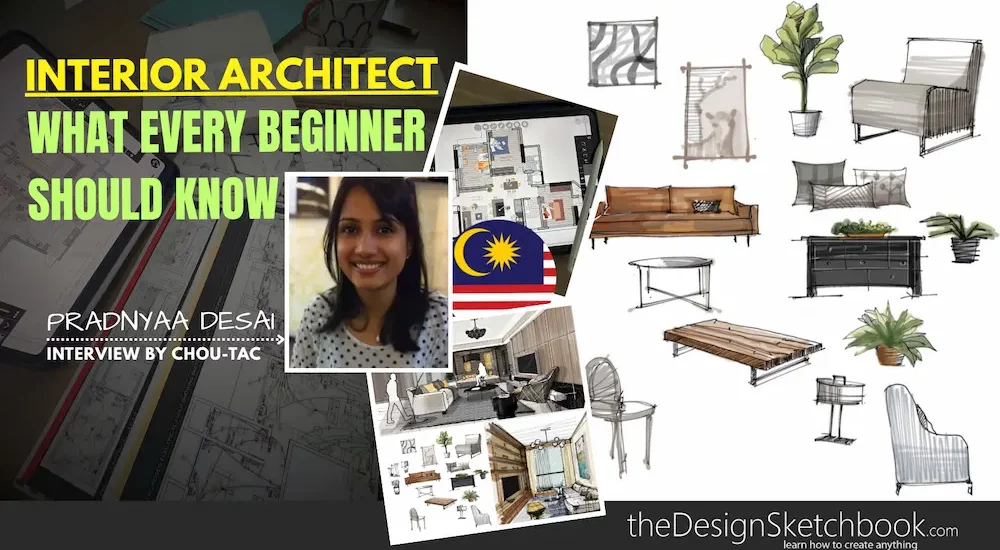

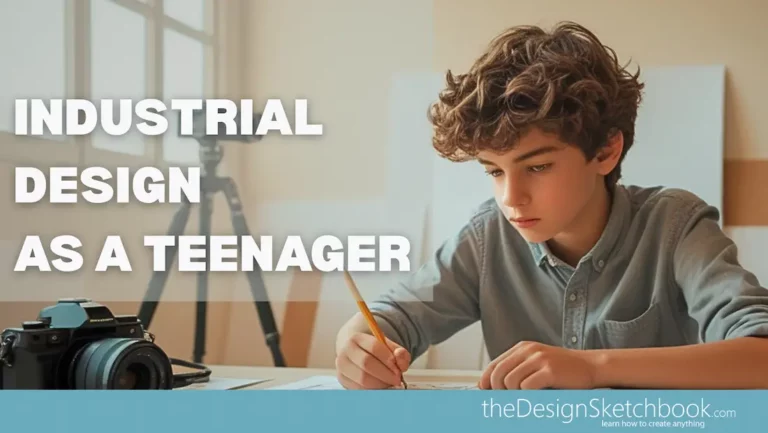
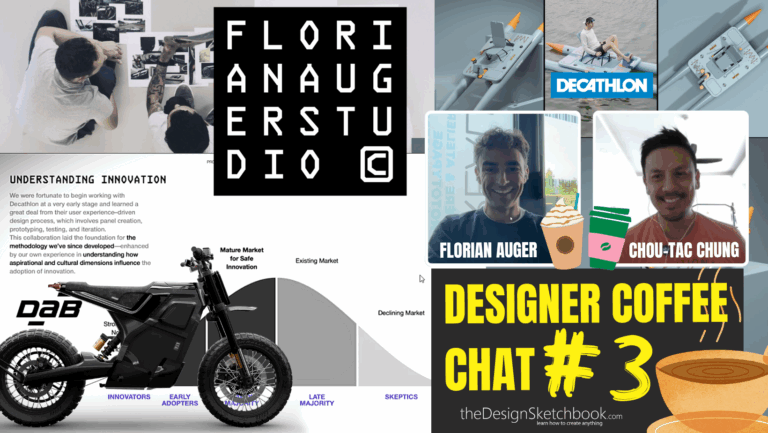


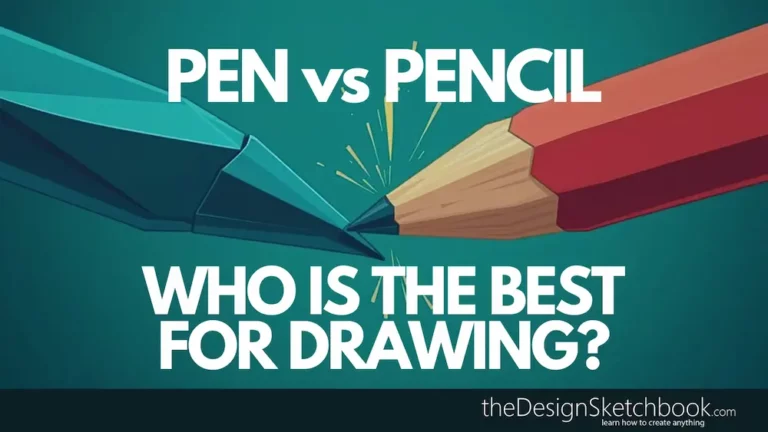
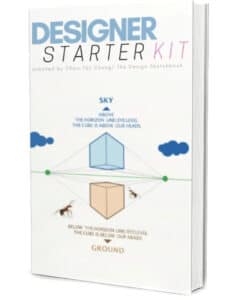

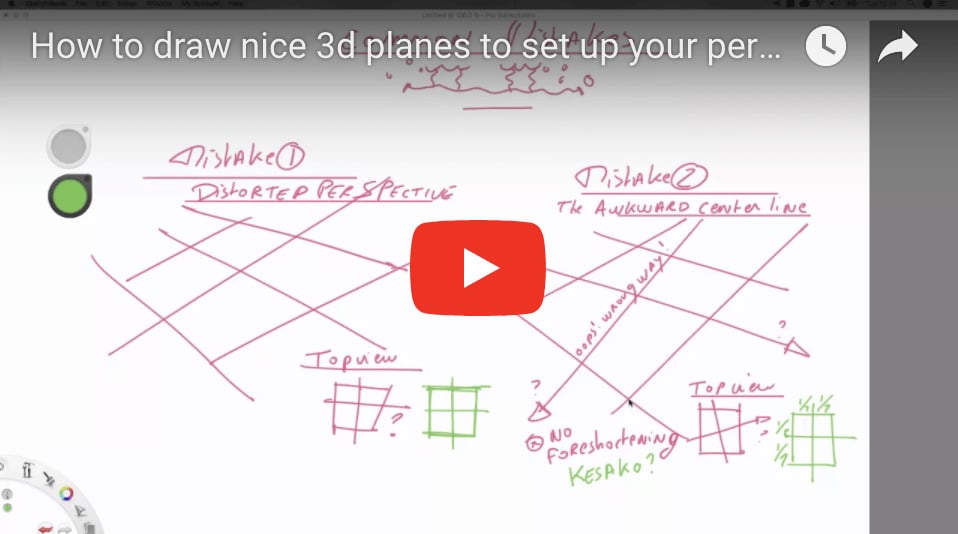

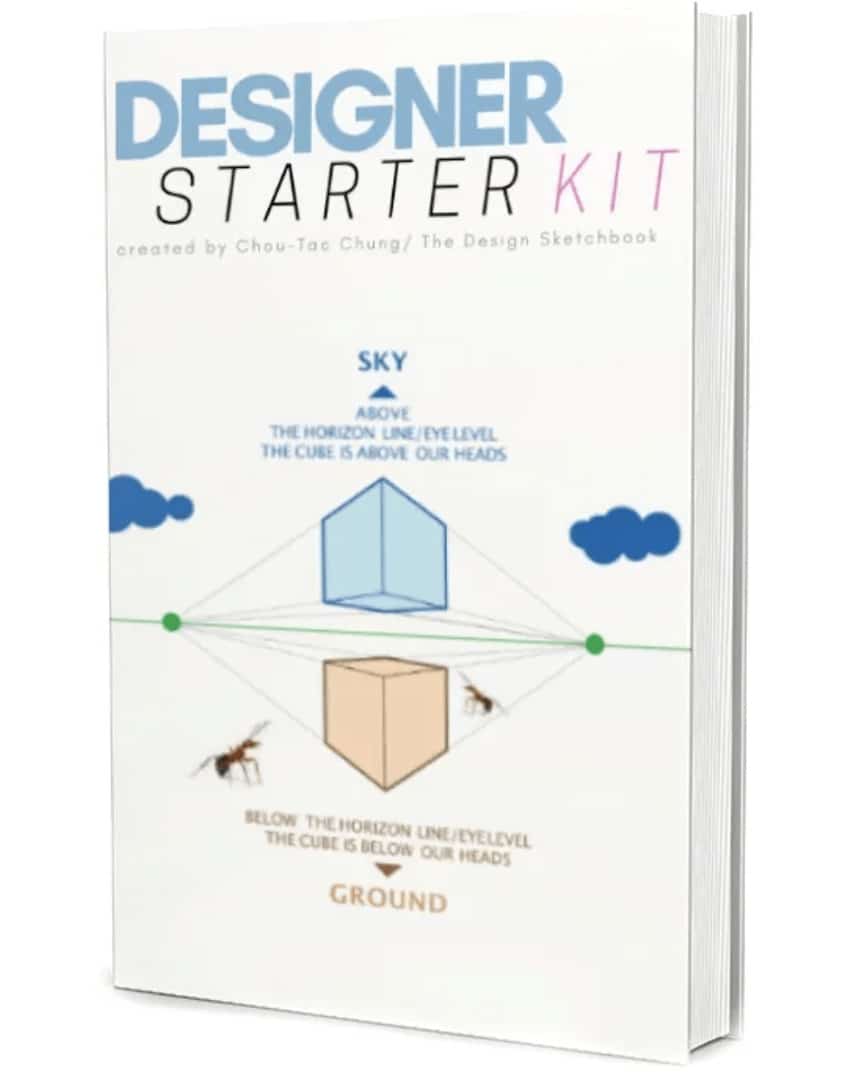


What a beautiful read! I love how you highlight sketching not just as a tool but as an emotional language. The way you blend culture, daily practice, and storytelling into her design is truly inspiring—offering valuable advice for anyone starting in interior architecture.
Yes, hand sketching is an amazing way to convey stories that touch the heart. 🙂